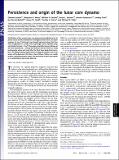| dc.contributor.author | Suavet, Clement Romain | |
| dc.contributor.author | Weiss, Benjamin P. | |
| dc.contributor.author | Cassata, William S. | |
| dc.contributor.author | Shuster, David L. | |
| dc.contributor.author | Gattacceca, Jerome | |
| dc.contributor.author | Chan, Lindsey | |
| dc.contributor.author | Head, James W. | |
| dc.contributor.author | Grove, Timothy L. | |
| dc.contributor.author | Fuller, Michael D. | |
| dc.contributor.author | Garrick-Bethell, Ian, 1980- | |
| dc.date.accessioned | 2014-07-10T14:28:55Z | |
| dc.date.available | 2014-07-10T14:28:55Z | |
| dc.date.issued | 2013-05 | |
| dc.identifier.issn | 0027-8424 | |
| dc.identifier.issn | 1091-6490 | |
| dc.identifier.uri | http://hdl.handle.net/1721.1/88244 | |
| dc.description.abstract | The lifetime of the ancient lunar core dynamo has implications for its power source and the mechanism of field generation. Here, we report analyses of two 3.56-Gy-old mare basalts demonstrating that they were magnetized in a stable and surprisingly intense dynamo magnetic field of at least ∼13 μT. These data extend the known lifetime of the lunar dynamo by ∼160 My and indicate that the field was likely continuously active until well after the final large basin-forming impact. This likely excludes impact-driven changes in rotation rate as the source of the dynamo at this time in lunar history. Rather, our results require a persistent power source like precession of the lunar mantle or a compositional convection dynamo. | en_US |
| dc.description.sponsorship | Massachusetts Institute of Technology (MIT-France Seed Funds Program) | en_US |
| dc.description.sponsorship | Centre National de la Recherche Scientifique (France) | en_US |
| dc.description.sponsorship | European Commission (Marie Sklodowska-Curie Actions, People Programme, Research Executive Agency Grant 298355) | en_US |
| dc.description.sponsorship | Ann and Gordon Getty Foundation | en_US |
| dc.description.sponsorship | United States. National Aeronautics and Space Administration (NASA Grant NNX12AH80G) | en_US |
| dc.language.iso | en_US | |
| dc.publisher | National Academy of Sciences (U.S.) | en_US |
| dc.relation.isversionof | http://dx.doi.org/10.1073/pnas.1300341110 | en_US |
| dc.rights | Article is made available in accordance with the publisher's policy and may be subject to US copyright law. Please refer to the publisher's site for terms of use. | en_US |
| dc.source | PNAS | en_US |
| dc.title | Persistence and origin of the lunar core dynamo | en_US |
| dc.type | Article | en_US |
| dc.identifier.citation | Suavet, C., B. P. Weiss, W. S. Cassata, D. L. Shuster, J. Gattacceca, L. Chan, I. Garrick-Bethell, J. W. Head, T. L. Grove, and M. D. Fuller. “Persistence and Origin of the Lunar Core Dynamo.” Proceedings of the National Academy of Sciences 110, no. 21 (May 21, 2013): 8453–8458. | en_US |
| dc.contributor.department | Massachusetts Institute of Technology. Department of Earth, Atmospheric, and Planetary Sciences | en_US |
| dc.contributor.mitauthor | Suavet, Clement Romain | en_US |
| dc.contributor.mitauthor | Weiss, Benjamin P. | en_US |
| dc.contributor.mitauthor | Gattacceca, Jerome | en_US |
| dc.contributor.mitauthor | Grove, Timothy L. | en_US |
| dc.relation.journal | Proceedings of the National Academy of Sciences | en_US |
| dc.eprint.version | Final published version | en_US |
| dc.type.uri | http://purl.org/eprint/type/JournalArticle | en_US |
| eprint.status | http://purl.org/eprint/status/PeerReviewed | en_US |
| dspace.orderedauthors | Suavet, C.; Weiss, B. P.; Cassata, W. S.; Shuster, D. L.; Gattacceca, J.; Chan, L.; Garrick-Bethell, I.; Head, J. W.; Grove, T. L.; Fuller, M. D. | en_US |
| dc.identifier.orcid | https://orcid.org/0000-0003-3113-3415 | |
| mit.license | PUBLISHER_CC | en_US |
| mit.metadata.status | Complete | |
